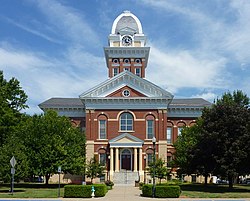Saline County, Missouri | |
|---|---|
 The Saline County Courthouse in Marshall | |
 Location within the U.S. state of Missouri | |
| Coordinates: 39°08′N93°12′W / 39.14°N 93.2°W | |
| Country | |
| State | |
| Founded | November 25, 1820 |
| Named after | The salt springs in the region |
| Seat | Marshall |
| Largest city | Marshall |
| Area | |
• Total | 767 sq mi (1,990 km2) |
| • Land | 756 sq mi (1,960 km2) |
| • Water | 11 sq mi (28 km2) 1.5% |
| Population (2020) | |
• Total | 23,333 |
| • Density | 30.9/sq mi (11.9/km2) |
| Time zone | UTC−6 (Central) |
| • Summer (DST) | UTC−5 (CDT) |
| Congressional district | 4th |
| Website | www |
Saline County is a county located along the Missouri River in the U.S. state of Missouri. As of the 2020 census, the population was 23,333. [1] Its county seat is Marshall. [2] The county was established November 25, 1820, and named for the region's salt springs.
Contents
- History
- Geography
- Adjacent counties
- Major highways
- National protected area
- Demographics
- 2020 census
- 2020 census 2
- 2000 census
- Education
- Public schools
- Private schools
- Post-secondary
- Public libraries
- Communities
- Cities
- Villages
- Unincorporated communities
- Government and politics
- Local
- State
- Federal
- See also
- References
- Further reading
- External links
Settled primarily by migrants from the Upper South during the nineteenth century, this county was in the region bordering the Missouri River known as "Little Dixie". In the antebellum years, it had many plantations operated with the forced labor of enslaved workers. One-third of the county population was African American at the start of the American Civil War, but their proportion of the residents has declined dramatically to little more than five percent.
Saline County comprises the Marshall, Missouri Micropolitan Statistical Area.
